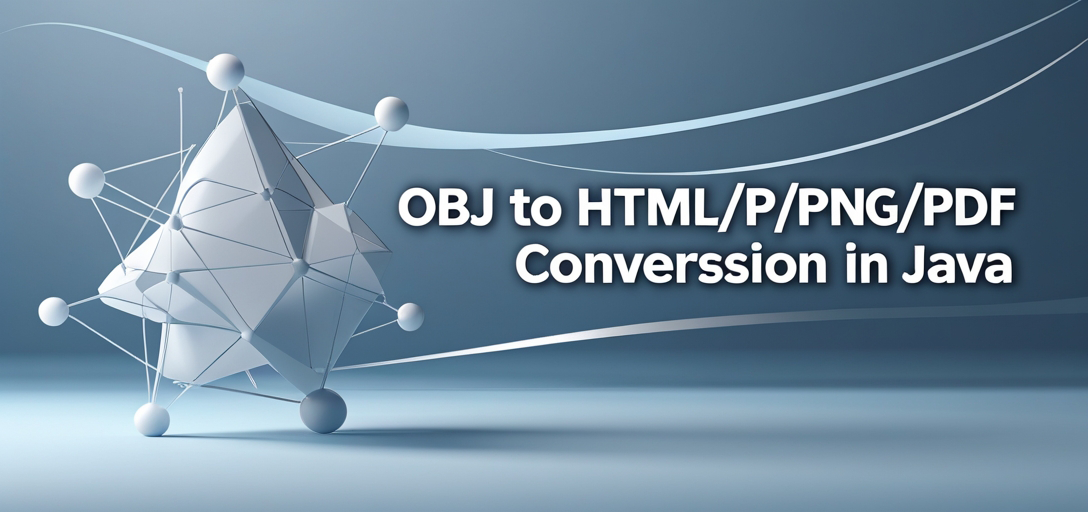Mastering File Conversion: Convert OBJ to HTML/JPG/PNG/PDF in Java Using GroupDocs.Viewer
Introduction
Are you looking to convert 3D model files effortlessly within your Java applications? Transforming OBJ files into accessible formats like HTML, JPG, PNG, or PDF can be challenging. This comprehensive guide simplifies this process using GroupDocs.Viewer for Java, a powerful library designed for complex file conversions.

In this tutorial, you’ll learn how to:
- Set up your environment with GroupDocs.Viewer
- Convert OBJ files into HTML, JPG, PNG, and PDF formats
- Optimize performance and troubleshoot common issues
Let’s dive in by setting up the prerequisites!
Prerequisites
Before starting with rendering OBJ files using GroupDocs.Viewer for Java, ensure you have:
- Required Libraries: Version 25.2 of GroupDocs.Viewer.
- Environment Setup: A development environment set up with Java and Maven.
- Knowledge Prerequisites: Basic understanding of Java programming and familiarity with Maven.
Setting Up GroupDocs.Viewer for Java
Maven Installation
To get started, add the following configuration to your pom.xml file:
<repositories>
<repository>
<id>repository.groupdocs.com</id>
<name>GroupDocs Repository</name>
<url>https://releases.groupdocs.com/viewer/java/</url>
</repository>
</repositories>
<dependencies>
<dependency>
<groupId>com.groupdocs</groupId>
<artifactId>groupdocs-viewer</artifactId>
<version>25.2</version>
</dependency>
</dependencies>
License Acquisition
- Free Trial: Download a free trial from the GroupDocs website.
- Temporary License: For extended testing, acquire a temporary license here.
- Purchase: Consider purchasing a full license for comprehensive access via this link.
Basic Initialization
To initialize GroupDocs.Viewer in your project:
- Import the necessary classes.
- Create an instance of
Viewerwith your OBJ file path.
This setup lays the foundation for rendering files into various formats.
Implementation Guide
Explore how to render OBJ files into different formats using GroupDocs.Viewer Java API.
Rendering OBJ to HTML
Overview: Convert 3D models into interactive, web-friendly HTML pages with embedded resources.
Step-by-Step Guide:
Set Up the Output Directory
Path outputDirectory = Paths.get("YOUR_OUTPUT_DIRECTORY"); Path pageFilePathFormat = outputDirectory.resolve("obj_result.html");Create Viewer Instance
try (Viewer viewer = new Viewer("YOUR_DOCUMENT_DIRECTORY/SAMPLE_OBJ")) { // Code for rendering will go here }Configure HTML View Options
HtmlViewOptions options = HtmlViewOptions.forEmbeddedResources(pageFilePathFormat);Render the OBJ Document
viewer.view(options);
Explanation: The HtmlViewOptions class ensures resources are embedded directly within HTML, providing a seamless viewing experience.
Rendering OBJ to JPG
Overview: Convert 3D models into high-quality JPEG images for easy sharing and display.
Step-by-Step Guide:
Set Up the Output Directory
Path outputDirectory = Paths.get("YOUR_OUTPUT_DIRECTORY"); Path pageFilePathFormat = outputDirectory.resolve("obj_result.jpg");Create Viewer Instance
try (Viewer viewer = new Viewer("YOUR_DOCUMENT_DIRECTORY/SAMPLE_OBJ")) { // Code for rendering will go here }Configure JPG View Options
JpgViewOptions options = new JpgViewOptions(pageFilePathFormat);Render the OBJ Document
viewer.view(options);
Explanation: The JpgViewOptions class handles conversion settings, including output path and image quality.
Rendering OBJ to PNG
Overview: Transform 3D models into PNG format, perfect for maintaining transparency in images.
Step-by-Step Guide:
Set Up the Output Directory
Path outputDirectory = Paths.get("YOUR_OUTPUT_DIRECTORY"); Path pageFilePathFormat = outputDirectory.resolve("obj_result.png");Create Viewer Instance
try (Viewer viewer = new Viewer("YOUR_DOCUMENT_DIRECTORY/SAMPLE_OBJ")) { // Code for rendering will go here }Configure PNG View Options
PngViewOptions options = new PngViewOptions(pageFilePathFormat);Render the OBJ Document
viewer.view(options);
Explanation: The PngViewOptions class configures PNG file generation, ideal for graphics requiring transparency.
Rendering OBJ to PDF
Overview: Convert 3D models into professional PDF documents suitable for distribution and printing.
Step-by-Step Guide:
Set Up the Output Directory
Path outputDirectory = Paths.get("YOUR_OUTPUT_DIRECTORY"); Path pageFilePathFormat = outputDirectory.resolve("obj_result.pdf");Create Viewer Instance
try (Viewer viewer = new Viewer("YOUR_DOCUMENT_DIRECTORY/SAMPLE_OBJ")) { // Code for rendering will go here }Configure PDF View Options
PdfViewOptions options = new PdfViewOptions(pageFilePathFormat);Render the OBJ Document
viewer.view(options);
Explanation: The PdfViewOptions class ensures accurate rendering into a portable and widely accepted PDF format.
Practical Applications
Explore real-world use cases for rendering OBJ files with GroupDocs.Viewer Java:
- Architectural Visualization: Convert designs into shareable formats like HTML or PDF.
- Online Product Catalogs: Showcase 3D models of products in web-based catalogs by converting to JPG or PNG.
- Educational Material: Create interactive educational content by rendering complex structures into HTML.
Performance Considerations
- Optimize Rendering Settings: Adjust quality settings based on output format requirements.
- Manage Resources Efficiently: Use try-with-resources syntax to close resources promptly.
- Memory Management: Monitor Java memory usage and optimize garbage collection for large files.
Conclusion
You’ve now mastered converting OBJ files into various formats with GroupDocs.Viewer for Java. These skills enable you to enhance web content or prepare professional documents effectively. As a next step, explore integrating these functionalities within larger applications or systems.
Ready to put your new knowledge into practice? Start experimenting and see how you can transform 3D models seamlessly in your projects!
FAQ Section
What formats does GroupDocs.Viewer for Java support?
- It supports a wide range of file types, including HTML, JPG, PNG, PDF, and more.
How do I troubleshoot rendering issues with OBJ files?
- Ensure the OBJ file path is correct and all dependencies are properly configured.
Can GroupDocs.Viewer handle large OBJ files efficiently?
- Yes, it’s designed to manage resource-intensive tasks effectively; however, monitor memory usage for very large files.
Is it possible to customize output quality when rendering images?
- Yes, you can adjust settings like image resolution in
JpgViewOptionsandPngViewOptions.
- Yes, you can adjust settings like image resolution in
How do I obtain a temporary license?
- Acquire a temporary license here.